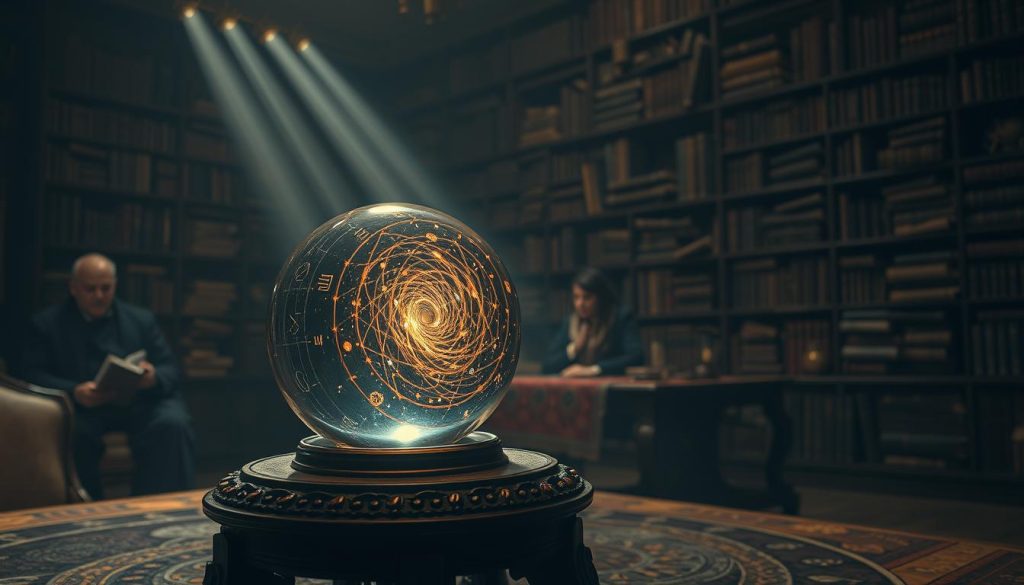Welcome to our ultimate guide. We open with a clear promise: together we’ll demystify the crystal ball, explore what it is, why it matters, and how you can use this gentle art today with curiosity.
Across the world, polished spheres made from clear quartz, amethyst, calcite, obsidian, or glass have offered a quiet focus for seekers. We’ll sketch a quick arc from ancient courts and Roman soothsayers to John Dee’s candlelit sessions and the Victorian parlor revival.
Expect plain-language definitions and simple practice notes. You’ll learn why a flawless polish helps focus attention, how guidance can arise through calm observation, and which modern rituals pair well with journaling or breathwork.
We invite you to approach this as exploration. No promises of certainty, only tools for clarity, calm, and better choices you can try today.
Key Takeaways
- We’ll demystify the art and offer clear, practical steps.
- Learn a brief history from ancient times to the modern world.
- Find simple benefits: calm, clarity, and fresh guidance.
- See how stones and polish help focus your inner compass.
- Ready-to-use tips let you practice a gentle ritual today.
- We’ll touch on cultural context, ethics, and mindful tools.
What Is Crystal Ball Reading? The Art of Scrying and Crystal Gazing
Scrying uses a smooth sphere as a gentle anchor for symbols, moods, and subtle impressions.
In simple terms, a crystal ball is a highly polished, reflective sphere used for divination. We soft-focus on the surface and notice symbols, feelings, or flashes that arise. This is a practice of attention, not prophecy.
Tools vary. Natural crystals like clear quartz, amethyst, and obsidian or a glass sphere work well. The common thread is a flawless, mirror-like polish that invites imagery to surface.
The process is calm. Slow breath, steady posture, and relaxed gaze help. The sphere’s symmetry often balances perception, letting the mind drift into symbolic space.
Different stones shift tone. Clear quartz can sharpen clarity. Obsidian feels deep. Amethyst soothes. Images are usually hazy or emotional rather than cinematic.
Terminology note: scrying and crystal gazing point to the same art scrying tradition. We’ll invite you to try a brief gaze later with an open question and gentle curiosity.
Crystal Ball Reading Explained: History, Meaning, and How to Try It
Across eras, polished spheres served as quiet bridges between the seen and the uncertain.
In ancient civilizations like Egypt and Greece, priests and sages used reflective tools as focused aids for counsel. Romans carried the practice widely until medieval authorities challenged such arts.
Medieval tensions left many practices hidden. Yet one clear record stands out: John Dee advising Elizabeth I with a scrying stone. His example shows how courtly counsel and secrecy could coexist.

The Victorian era revived public curiosity. Parlor séances and traveling Romani traditions spread methods across Europe. Practices persisted in folk paths despite stigma.
Across continents, the object took many forms—one famous Qing dynasty sphere even weighed about 49 pounds, a reminder of global reach.
- Uses ranged from guidance on love, health, and wealth to meditative healing.
- The pattern is familiar: curiosity, caution, and reinvention keep this art alive.
Meanings and Main Uses: Divination, Meditation, and Healing
A polished sphere can act as both a mirror for inner symbols and an anchor during stillness. We use this object in three main ways: gentle divination, focused meditation, and supportive healing work.
Divination and guidance: the practice of gazing
Divination here means symbolic insight, not fixed predictions. Set an intention, soften your eyes, note images, then turn metaphors into small steps. Keep a journal. Track colors, moods, or an angel number that repeats.
Meditation and energy work: focus and intuition
Use the sphere as a visual mantra. It calms breath and steadies attention. Placing a sphere nearby can complement breathwork and boost intuition. The shape encourages balance in an energy layout.
Crystal healing: chakras, reiki, and presence
Some practitioners place spheres near chakras or during reiki sessions. This can support a sense of safety and connection. Note claimed healing properties like soothing or grounding, then test what feels right.
“Practice is how intuition grows — small steps, steady attention.”
- Use journaling to turn images into choices.
- Respect boundaries: this complements care, not replaces it.
- Pick the use that lights you up first and explore from there.
How to Try It: A Step‑by‑Step Guide to Crystal Ball Gazing
Start small: find a sphere that feels right in your hands and a quiet corner to sit.
Choosing your sphere
Pick by feel. Clear quartz often sharpens focus, obsidian gives depth, and amethyst soothes. Size matters — palm-sized works for most starters. Use a secure stand so the orb stays steady.
Cleansing and space
Set an intention. Clear the area with smoke or sound. Avoid soaking porous stones in salt water. Dim lights, silence phones, and light a candle or soft lamp to calm the nervous system.

The gazing process
Place your hands on the sphere for a minute to connect. State a clear question, then release your grip. Soften your eyes and hold a gentle focus. Don’t strain — let impressions float up like clouds.
Interpreting symbols
Keep a small journal. Note colors, emotions, and any repeating signs. Try a 10–15 minute session, and repeat a theme across three days to spot patterns. Trust your intuition and choose curiosity over pressure.
“Small steps and steady attention build insight.”
Across Cultures: How Different Traditions View Crystal Balls
Around the world, people treat the sphere as an art object, a tool for counsel, or a meditation anchor. We notice how expectation shifts by culture and context. Some see prediction; others favor presence and energy work.
Western perspectives frame the sphere as fairground mystic gear, film icon, and museum piece. In pop culture it often signals fortune-telling and glamour. Yet artists and collectors also value the form for its light, symmetry, and mystery.
Eastern approaches emphasize quiet practice. Many traditions pair polished spheres with breath, subtle energy work, and seated meditation. In these paths the object supports balance and focus more than spectacle.
Many cultures, many practices include Chinese ideas of Qi and placement for flow. Native American uses often weave protection, healing, and spirit communication into community rituals. Hindu-Buddhist contexts may use the sphere as a steady point for disciplined insight.
- Culture shapes expectation: prediction versus presence.
- New age circles mix breathwork, mantra, and modern rituals.
- Respect matters — borrow thoughtfully and credit sources.
“Across traditions, the same object can teach different kinds of attention.”
The Benefits: Clarity, Balance, and Reduced Stress
A calm, steady practice often clears mental clutter and makes choices feel more manageable.
Mind: A short gaze slows thought, sharpens insight, and helps with decision-making.
We notice emotions without getting swept away. This builds simple emotional balance that serves daily life.
Body: Slower breath eases tight shoulders and lowers stress.
Try a gentle roll of a smooth sphere over forearms or calves as a brief massage.
This tactile work supports relaxation and helps reduce stress naturally.
Spirit: Regular sessions can grow intuition and deepen a quiet sense of connection.
Many report feeling steadier and more open to inner guidance after a few weeks.
Practical notes: Pair the practice with a short body-scan before you start.
Keep water, rest, and movement as part of your routine—rituals work best alongside basic health habits.
“Small sessions add up — peace and steady insight come with patience.”
| Area | Reported Benefit | Simple Practice | Frequency |
|---|---|---|---|
| Mind | Clarity, decision ease | 5–10 min soft gaze; journal one insight | Daily or 3× week |
| Body | Relaxation, lowered stress | Micro-massage with smooth sphere; breath work | After tense tasks |
| Spirit | Stronger intuition, gentle connection | Short meditation with intention; note angel number signs | Weekly check-ins |
| Overall | Balanced energy, calming ritual | Body scan + 10 min gaze; track mood | 3–7 weeks for pattern spotting |
- We honor traditional healing ideas, while keeping your experience central.
- Use a one-page benefits tracker to log mood, sleep, focus, and creative flow.
- No forcing outcomes—aim for steady peace, not instant answers.
Tools, Setup, and Best Practices for Your Space
Setting a practical, calm stage boosts focus and invites subtle guidance. Small shifts make a big difference.
Where to place your crystal ball
Choose a stable stand and a calm corner. The center of the home helps balanced flow. Bedrooms can encourage lucid, dreamlike energy. An altar gives a dedicated spot for ritual and reflection.
Feng shui tips
Select a sector that matches your intention—knowledge, relationships, or career—and let the placement support your aims. Soft lighting and uncluttered space amplify quiet attention.
Crystal ball vs. seeing ball
Natural crystal spheres often show inclusions and character. Flawless glass “seeing balls” give a mirror-like surface. Both work well; choose the one that feels right for your practice.
Care, timing, and kit
- Clean with a soft cloth; store away from direct sun and dust.
- Practice in the morning for clarity or evening to unwind before journaling.
- Keep a ritual kit: candle, notebook, timer, and gentle chimes or white noise.
Ergonomics & safety
Sit with feet grounded, shoulders relaxed. Avoid focusing sunlight through the sphere—treat it like a lens near flammables.
Ask your space what it wants to become, then listen for a small whisper back.
Myths, Ethics, and the Scientific Lens
Curiosity is welcome, but myth-busting helps us keep practice honest and kind. This short section looks at common misunderstandings, ethical ground rules, and what science tells us about why images appear.

Debunking common myths: beyond magic and certainty
No one guarantees the future. Divination offers perspective, not prophecy. Sessions give options, not fixed outcomes.
Free will and responsible guidance
We center empowerment over dependency. Good readers make clear limits, ask consent, and avoid making medical or legal claims.
Your choices shape results. Think of a session as a map of possible routes, not a locked path.
The psychology of scrying: patterns, meaning, and skepticism
Our brains love patterns. Researchers call this tendency apophenia. That explains why vague images can feel meaningful.
Use healthy skepticism. Treat impressions as prompts for reflection, journaling, or seeking professional therapy when life is heavy.
“Use what resonates, release the rest, and keep your agency front and center.”
- We suggest practical next steps: small actions matter more than dramatic signs.
- Respect privacy, refer out when beyond scope, and avoid creating dependency.
- Return to sessions often for perspective across seasons — reading often helps track change, not foretell fate.
Conclusion
Wrap the guide with one clear invitation: make space and take ten minutes today for a quiet practice. Place a sphere in a calm corner, set an intention, then sit and breathe.
We’ve walked from ancient civilizations to modern life, honoring origins crystal stories and many cultures that shaped this art. Many people find peace, greater focus, and subtle healing benefits by using crystal gazing as a short daily ritual.
Keep health and therapy in mind. Be gentle with expectations. Return often, journal small insights, and let this ultimate guide be a starter for a life of kinder attention and steady connection.
Blessing: may your practice crystal be steady, your steps light, and your inner guidance kind.
